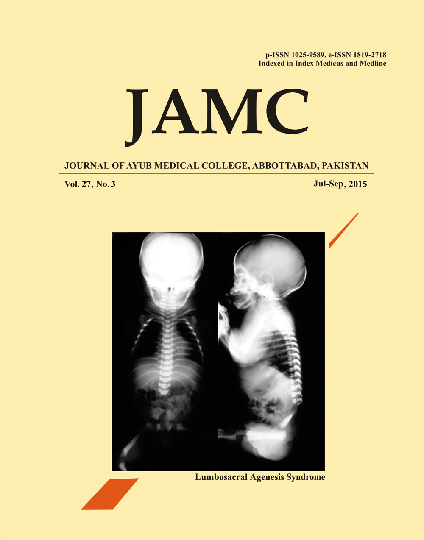MORBIDITY OF SURGERY IN PREVIOUSLY UNDIAGNOSED CIRRHOTIC PATIENTS
Abstract
Background: Undiagnosed cirrhotic patients are frequently encountered during routine and emergency surgery. These patients have a higher incidence of blood loss & wound infection, resulting in prolonged hospital stay. This study was conducted to highlight the possible complications which result in prolonged hospital stay in these patients. Methods: A total of 38 patients were incidentally found to have cirrhosis out of a total of 1560 patients who underwent abdominal operation. Diagnosis was confirmed on per-operative liver biopsy and was suspected preoperatively in patient having abnormal liver function test. Per-operative bleeding, postoperative wound infection and hospital stay was compared in cirrhotic and non-cirrhotic patients. Results: The mean blood loss was 310 ml in cirrhotic patients as compared to 205 ml in non-cirrhotic patients which was statistically significant (p-value 0.008). Post-operative infection rate was 21% in cirrhotic patients compared to non- cirrhotic patients 5%. Significance was tested using Pearson Chi square test (0.042). The Average hospital stay was 10 days in cirrhotic patients and 7.5 days in non-cirrhotic patients respectively which was statistically significant (p-value 0.006). Conclusion: There is statistically significant difference in per-operative bleeding, wound infection and hospital stay in cirrhotic and non-cirrhotic patients.References
Csikez NG, Nquyen LN, Teng JF, Shah SA. Nationwide volume and mortality after elective surgery in cirrhotic patients. J Am coll Surg 2009;208(1) 96–103.
Mahmood S. Ascites. The profile of patients and its causes. Specialist vol No 3 1990;96–97.
Younossi ZM , Sephenova M, Afendy M, Fang Y, Younossi Y, Mir H, et al. Changes in prevalence of most common causes of chronic liver disease in Unites States from 1988 to 2008. Clin Gastroenterol Hepatol 2011;9(6)524–30.
Neef H ,Manaskin D, Spangenburg HC, Hopt UT, Makowiec F. Peroperatve mortality after non hepatic general surgery in patients with liver cirrhosis: An analysis of 138 operation in the 2000s using Child and MELD score . J Gastrointest Surg 2011;15(1):1–11.
Boucher IA. Postmortem study of frequency of gallstones in patients with cirrhosis of the liver. Gut 1969;10(9):705–10.
Hickman MS, Schwesinger WH, Page CP. Acute cholecystitis in diabetics. A case-control study of outcome. Arch Surg 1988;123(4):409–11.
Geode BD, Klitsie PJ, Lange JF. Morbidity and mortality related to non-hepatic surgery in patients with cirrhosis; a systemic review. Best Pract Res Clin Gastroenterol 2012;26(1):47–59.
Aranha GV, Sontag SJ, Greenlee HB. Cholecystectomy in cirrhotic patients :a formidable operation. Am J Surg1982;143(1):55–60.
Nicoll A. Surgical risk in patients with cirrhosis. J Gastroenterol Hepatol. 2012;27(10):1569–71.
McGillicuddy JW, Villar JJ, Rohan VS, Bazaz S, Taber DJ, Pilch NA, et al. Is cirrhosis a contraindication to laproscopic cholecystectomy. Am Surg 2015;81(1):52–5.
Schwartz SI. Biliary tract surgery and cirrhosis: a critical combination. Surgery 1981;90(4):577–83.
Hamid S, Siddique M, Jaffri W, Shah H, Khan H, Ahmed M. Outcome of biliary tract surgery in cirrhitics;a case control study. Ann R Coll Surg Engl 1993;75(6):434–6.
Published
Issue
Section
License
Journal of Ayub Medical College, Abbottabad is an OPEN ACCESS JOURNAL which means that all content is FREELY available without charge to all users whether registered with the journal or not. The work published by J Ayub Med Coll Abbottabad is licensed and distributed under the creative commons License CC BY ND Attribution-NoDerivs. Material printed in this journal is OPEN to access, and are FREE for use in academic and research work with proper citation. J Ayub Med Coll Abbottabad accepts only original material for publication with the understanding that except for abstracts, no part of the data has been published or will be submitted for publication elsewhere before appearing in J Ayub Med Coll Abbottabad. The Editorial Board of J Ayub Med Coll Abbottabad makes every effort to ensure the accuracy and authenticity of material printed in J Ayub Med Coll Abbottabad. However, conclusions and statements expressed are views of the authors and do not reflect the opinion/policy of J Ayub Med Coll Abbottabad or the Editorial Board.
USERS are allowed to read, download, copy, distribute, print, search, or link to the full texts of the articles, or use them for any other lawful purpose, without asking prior permission from the publisher or the author. This is in accordance with the BOAI definition of open access.
AUTHORS retain the rights of free downloading/unlimited e-print of full text and sharing/disseminating the article without any restriction, by any means including twitter, scholarly collaboration networks such as ResearchGate, Academia.eu, and social media sites such as Twitter, LinkedIn, Google Scholar and any other professional or academic networking site.









